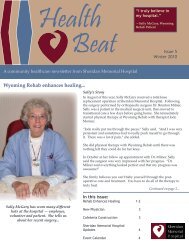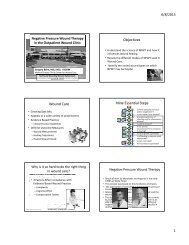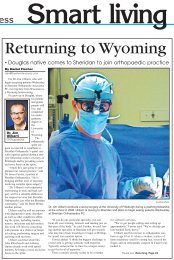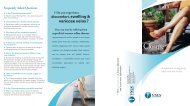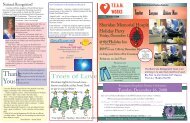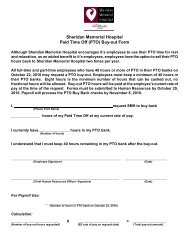Layout 1 (Page 1) - Sheridan Memorial Hospital
Layout 1 (Page 1) - Sheridan Memorial Hospital
Layout 1 (Page 1) - Sheridan Memorial Hospital
Create successful ePaper yourself
Turn your PDF publications into a flip-book with our unique Google optimized e-Paper software.
Smart<br />
THE<br />
Press SHERIDAN livingFriday,<br />
Octo<br />
www<br />
Hand<br />
sanitizers<br />
and food<br />
safety<br />
Sales of hand sanitizer are on<br />
the rise: up 19 percent from a year<br />
ago, according to one report.<br />
This is not surprising considering<br />
the increase in awareness and<br />
concern about the current flu season,<br />
and this trend is likely to continue<br />
as flu<br />
activity<br />
continues to<br />
increase<br />
nationwide.<br />
There is<br />
no doubt<br />
that the use<br />
of sanitizers<br />
is a good<br />
defense<br />
Kentz<br />
Willis<br />
University<br />
Extension<br />
Educator<br />
against the<br />
spread of<br />
influenza<br />
and other<br />
illnesscausing<br />
microbes.<br />
In fact,<br />
some health organizations even prefer<br />
their use to hand washing.<br />
Why? To start with, sanitizers<br />
take less time — meaning we are<br />
more likely to use them. In addition,<br />
many individuals simply don’t<br />
wash their hands correctly, leaving<br />
some germs behind.<br />
Further, sanitizers may be less<br />
likely to dry out the skin, an important<br />
point considering the dry winter<br />
months ahead.<br />
However, don’t throw away<br />
your soap just yet! There are some<br />
very good reasons why soap and<br />
water should still be your first<br />
defense — especially when food is<br />
involved.<br />
Hand sanitizers are less effective<br />
against viruses and spores like<br />
Norovirus and C. Difficile, which<br />
are commonly associated with<br />
food-borne illness. In addition,<br />
some sanitizer ingredients aren’t<br />
things that you would like to eat,<br />
leading to potential contamination<br />
if not used correctly.<br />
Also, food preparers frequently<br />
have wet hands, or substances on<br />
their hands that are high in protein,<br />
both of which may decrease the<br />
effectiveness of hand sanitizers.<br />
Please see Sanitizer, <strong>Page</strong> C3<br />
Preventing pressure ulcers<br />
• SMH reducing costs by better care of wounds<br />
The <strong>Sheridan</strong> Press/Michael Sullivan<br />
Registered nurse Erin Bowers fits a waffle boot onto a patient’s foot Tuesday at <strong>Sheridan</strong><br />
<strong>Memorial</strong> <strong>Hospital</strong>. The boot is a preventive measure against pressure ulcers.<br />
By Tom Cotton<br />
options@thesheridanpress.com<br />
To reduce costs, increase patient comfort,<br />
and comply with federal guidelines,<br />
<strong>Sheridan</strong> <strong>Memorial</strong> <strong>Hospital</strong> is taking an<br />
active approach to decreasing the number<br />
of pressure ulcers in patients.<br />
A <strong>Memorial</strong> press release states that<br />
pressure ulcers (also known as bedsores)<br />
affect millions of people per year. It adds<br />
that the federal Centers for Medicare &<br />
Medicaid Services (CMS) estimates the<br />
cost of treating pressure ulcers at $11 billion<br />
per year.<br />
CMS is mandating that hospitals take<br />
an aggressive approach in making sure<br />
that pressure ulcers don’t develop during<br />
a hospital visit. <strong>Sheridan</strong> <strong>Memorial</strong><br />
<strong>Hospital</strong> has followed suit.<br />
According to the Web site<br />
www.webmd.com, a pressure ulcer “is an<br />
injury to the skin and/or tissues under the<br />
skin. Constant pressure over an area of<br />
skin reduces blood supply to the area.<br />
Over time, it can cause the skin to break<br />
down and form an open sore.”<br />
Over the past six months, <strong>Memorial</strong><br />
<strong>Hospital</strong> has employed the Pressure Ulcer<br />
Prevention Program to help reduce the<br />
number of patients afflicted with pressure<br />
ulcers.<br />
Marta Ostler, a certified wound care<br />
specialist at the hospital, says assessments<br />
are done to all admitted patients<br />
and include monitoring patients’ skin,<br />
nutrition, mobility and any previous<br />
sores.<br />
After admission, patients are monitored<br />
approximately every 12 hours to<br />
make sure they are not developing sores.<br />
“It takes a lot of equipment and manpower<br />
to prevent pressure ulcers,” Ostler<br />
noted.<br />
She explained that not only nurses and<br />
primary care physicians are involved in<br />
preventing pressure ulcers, but also dietitians,<br />
families and potentially surgeons.<br />
“We have known for years that wound<br />
care is a team thing,” said Ostler.<br />
Better mattresses in the hospital are<br />
also preventing pressure ulcers. The mattresses<br />
are made of a jellylike substance<br />
that reduces pressure on a patient’s body.<br />
The new program seems to be helping.<br />
According to Lisa Nicholls, a certified<br />
wound care specialist at <strong>Memorial</strong>, for<br />
patients in the hospital three days, 20 percent<br />
developed a pressure ulcer in<br />
September 2008. That dropped to 11 percent<br />
in March 2009.<br />
Please see Ulcers, <strong>Page</strong> C3
Ulcers<br />
(Continued from <strong>Page</strong> C1)<br />
“We are very pleased with the results,” said<br />
Peggy Callantine, chief nursing officer at<br />
<strong>Memorial</strong> <strong>Hospital</strong>, in the release. “We<br />
feel that our improved outcomes have to do<br />
with increased staff education on the identification<br />
of pressure ulcers when patients<br />
are admitted to the hospital and the evidence-based<br />
interventions we've put into<br />
place.”


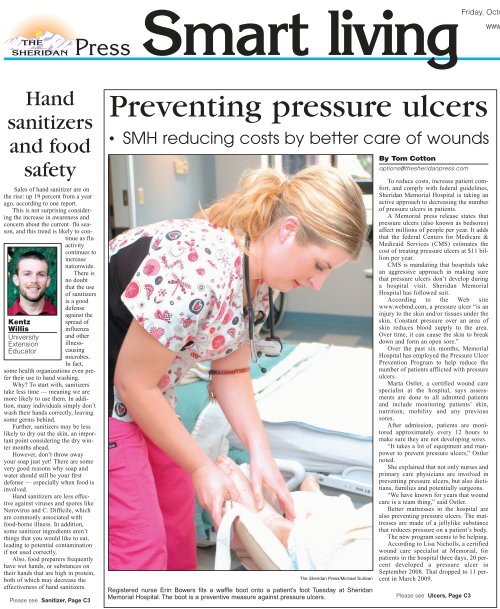

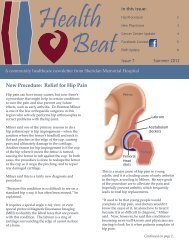
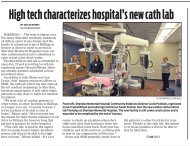
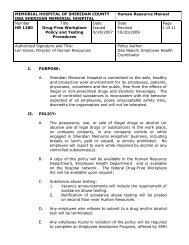

![Adult - Medical History Form [PDF] - Sheridan Memorial Hospital](https://img.yumpu.com/40577874/1/190x245/adult-medical-history-form-pdf-sheridan-memorial-hospital.jpg?quality=85)
